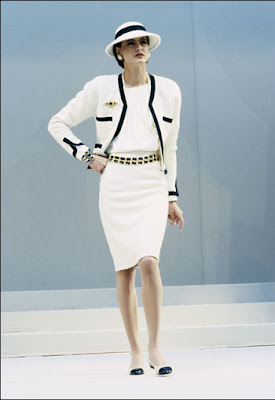
According to fashion writer Leah Chernikoff,
"In the ’80s Inès de la Fressange reigned as the most super of the supermodels. Muse to Karl Lagerfeld at Chanel throughout the decade (until the two had a falling out in 1989) she was, according to the WSJ, the first model to sign an exclusive modeling contract with the house, and later went on to serve as the model for Marianne, the symbol of France.
Today, at 53, de la Fressange is back. She signed on as the brand ambassador for Roger Vivier when the label was revived eight years ago after being acquired by Diego Della Valle and Tod’s group, marked the end of her feud with Lagerfeld by walking at the Chanel spring 2011 show, and just yesterday it was announced that she is the new face of L’Oreal Paris. “I believe in the slogan ‘Because we’re worth it!’” she said in a statement for L’Oreal, “I love those words, which are still perfectly relevant today.”
We got the chance to talk with the legendary model over Paris Fashion Week at Roger Vivier’s presentation about her work for Vivier, her thoughts on the state of fashion and luxury today, her reaction to Galliano’s ousting from Dior, and why she doesn’t like to go to runway shows.
Fashionista: Why did you decide sign on to be the “brand ambassador” for Roger Vivier?
Inès de la Fressange: Diego della Valle asked me to relaunch the brand. He said he wanted something very Parisian and that he wanted the product to be important [without] advertising. We don’t have advertising or marketing. I take care of the communication and Bruno [Frisoni] was taking care of designing the prdoucts. Usually when you have a meeting you say you have to think about it but I was so thrilled about Roger Vivier coming back, especially since I knew Vivier personally, that I immediately said “Yes.”
Was it daunting to be tasked with reviving an old brand?
For us in the fashion world, the name is like Balenciaga. A journalist even called my office asking for the direct line of Mr. Vivier. It meant I had to restart everything again. It reminds me of when I was working for Chanel years and years ago–your mother remembers–[at this point I interject, "I remember!"] and people would tell me, “Oh Chanel it looks very strict and bourgeois, it’s for an old lady, it’s tweed,” and I had to explain, “No, Coco Chanel once in her life was young and she was very modern,” and now everyone knows. It’s the same with Vivier. He invented the high boot, the stiletto, the comma heel…he’s inspired everyone.
Do you think it’s easier to revive an old luxury label than to create a new one?
There aren’t many luxury companies that are new. We’re an old name but we’re new, and that’s funny. The newest luxury company is maybe Jean Paul Gaultier and he’s been working for 30 years. Lacroix doesn’t exist anymore. Even someone like Guillaume Henri, he’s designing Carven and it’s an old name.
What makes a luxury brand successful?
What makes a brand big is when you don’t imagine a customer. Like a Burberry trench coat–you don’t think about who’s going to wear it, you’re just dying ot have one. Or an Hermes Kelly bag–maybe you could have a Kelly bag [I interject, "I wish!"] with stickers of Ganesha on it [yes, she said that and now I want a Kelly bag with stickers of Ganesha on it] and maybe your grandmother, too. The same with Vivier’s shoes–your mother can come, your grandmother can come, and I guess you’re going to find something, too. I like that it’s all about desire–very special things you can’t find anywhere else.
You walked in Chanel’s last show. Do you attend shows during fashion week?
I go to Chanel but otherwise I have to be at the office. The shows are for journalists and buyers. To go there to wait to see the show and then you have to go and kiss the designer after, it takes too much time. I like to go to couture because couture you get to see really close up and then after you never see the clothes anymore. Ready-to-wear I can see in the shops.
What do you make of all the drama that’s surrounded this past fashion week over Galliano being fired from Dior?
Fashion is like this. It’s a reflection of the times–look at North Africa. There’s always turbulence. They’re artists, extravagant people, lots of money, enormous companies, there are lots of media and photographers and then there are images all over the world, and everything goes very quickly. There’s a lot of hypocrisy too because we know that people are in a bad way, when they take drugs or alcohol they can say terrible things–usually they’re not that famous.
Source: Fashionista

















No comments:
Post a Comment